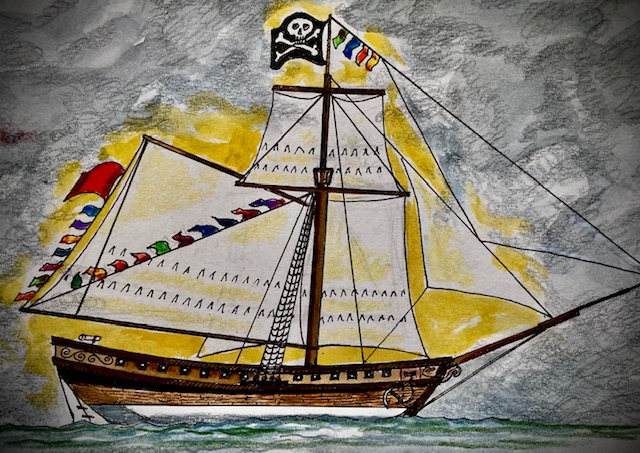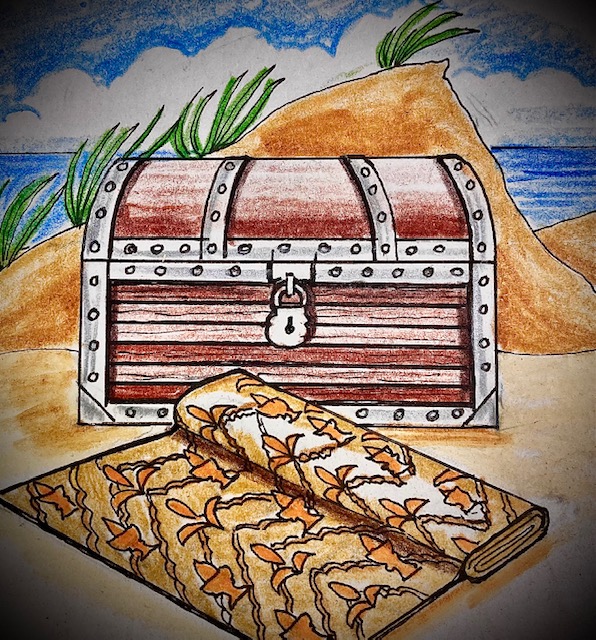When it comes to seafaring stories, what is truth and what is a stretch of over imagination. Aye! That’s always the twist, isn’t it? I guess it lies in what you choose to believe, what you think you saw, or how many witnesses you trust. Then again, does it matter? After a lifetime of studying our ocean, bays, history and being part of it myself, I choose to believe in a local ghost ship called “Sea Emerald”.
South Hampton was one of Long Island’s earliest English colonies. By the golden age of piracy, it was quite established as a town. Yet eastern Long Island, then considered part of New England, was very wild and secluded and its inhabitants were often accused of being in cahoots with “Gentlemen of Leisure’’ as pirates often called themselves. Their ships were mostly fast, heavily armed schooners and not the heavy, cumbersome ships often shown in movies such as Pirates of the Caribbean. They often visited Long Island to quickly off-load any ill-gotten gains and be off again before they could be apprehended. No one cared to bother them here on Long Island where most everyone was profiting from dealing with those “Sea Dogs”.

In 1703, shortly after Captain Kidd was hanged in London for piracy, a sleek, well-armed sloop appeared in Peconic Bay just north of South Hampton. She flew no colors. Several South Hampton aldermen rowed out to her and noticed that she displayed the name “Sea Emerald” on her transom. The menacing crew on board were a varied mix of nationalities. Each one bristled with knives, cutlasses and flintlock pistols. One of their crew, called Captain Turner by them, was called to the railing. He had the crew lower a boarding net. Up the aldermen awkwardly climbed. The crew searched them and found only one sharp “Dirk” stuck in the side of a boot. The pirate who found it added it to his collection. Capt. Turner took the aldermen to his cabin to talk ‘‘Business”. The South Hamptoners inquired why he was anchored in Peconic Bay. He replied that it was common knowledge amongst “The Brethren of the Sea” that the East End of Long Island, especially South Hampton, was very accommodating to “Men of Fortune” such as they and the local population made it easy for pirates to divest themselves of certain ill-gotten goods for more easily deposable forms of currency, preferably silver.

Captain Turner so happened to have a hull full of gold, silver and jewels plus an even greater fortune in fine India Damask aboard which he had “borrowed” from an English East India ship off the coast of Madagascar nearly a year before. Damask is made of gold and silver thread weaved into the most expensive and desirable material worth a ransom, more than precious metal and jewels. The problem was, that it was hard to exchange for more common riches. Bringing Damask heisted from an English East India trade vessel into the harbors of Boston, Providence, Philadelphia or New York was sure to be noted. Trying to get rid of it all at once would smack of piracy and off to the hangman Captain Turner and the crew would go. So basically, it was “Let’s make a deal time”. It was easier for land-lubing South Hamptoners to buy it at a hefty discount, cart it over land and sell it piece by piece over a long period with nary a king’s official (Who wasn’t in on it already) knowing a thing. Deal done!
In a day, the Damask was unloaded and quickly Capt. Turner turned his ship about and sailed off with only his gold, silver and jewels plus the profit made by selling the Damask to the South Hampton folks. The South Hamptoners now had the market on Damask cornered to feed the black market in New York, etc., to rich society families like the Livingstons, Clintons, Floyds and Jones family who had shady piratical pasts themselves before they became pillars of society. Somehow, things never change.
Several days later alderman James Cooper was riding in his ox cart along the beach at low tide when he spied a large mass ahead.
It was very misty and hard to define until he got up close. Being one of the aldermen who dealt with Captain Turner a few days earlier, he knew it was the “Sea Emerald”. Her sails were ripped and tattered. Her yardarms had crashed on deck. There was a cavernous hole in the hull below the waterline. The anchor line was lying on the beach. He used it to climb on deck. There was not a pirate to be found onboard. Several times he screamed out Turner’s name. No answer. Scattered about were knives, cutlasses, and weapons of all sorts, but not a body or a drop of blood appeared on the deck. The cannons had shifted about but mysteriously there had been no foul weather other than mist since the “Sea Emerald” had left Peconic. He scoured the ship for treasure. He found not a farthing.
Upon getting back to town, he called all the aldermen and they returned to the beached ship with him. There was not a wisp of evidence to be culled from the wreck. They decided to return the next day with every able-bodied person and some Montauk Indians to strip the bones of the ship of everything they could lay their hands on. On the way home at dusk, they wondered what happened. Not that they felt bad about it. They all were thieves at heart anyway and now would salvage anchors, lines, lanterns, large oak beams, masts, weapons and the canvas remains of its sails. Nothing much would be left. They went home and got a good night’s sleep as they would be working hard the next day.
Morning brought a thick fog that deterred no one in South Hampton. They jabbered excitedly as they all walked east along the beach with tools, food and empty ox carts to haul their gains. They walked on and on but began to feel uneasy when they could not find the wreck or any signs of it. It was so wrecked that it was impossible that any tide would refloat it. All the aldermen stood bewildered at the ocean’s edge. They felt somewhat embarrassed. They strained their eyes into the fog beyond the waves. One of them raised his large spyglass but nothing appeared. Suddenly the fog began to lift. A child yelled “A ship! A ship!” and pointed. There, with her starboard side to the shore, was the “Sea Emerald”! Her masts were straight and true, her sails white as snow, the sun glittering off the brass of her polished cannons. A hundred different colorful flags flew from her yard arm and masts topped off by a giant Jolly Roger flag. They rubbed their eyes in disbelief. They trained the powerful spyglass on her deck but could see no crew and no Captain Turner at the ship’s wheel. They watched as she turned southeast and made her way over the horizon.
They shuffled home in silence listening to the creaking of the ox cart and an occasional burp by an alderman and some ox farts. Back in South Hampton the aldermen gathered and decided to check on the large bolts of Damask they had hidden in the basement of their Prayer House. They went down the creaky stairs and used the big iron forged keys to remove the locks and chains that fastened the thick oak door. Over the years it held criminals and even witches during those terrible years. No one could get in or out without the keys. They raised their lanterns and gasped when they realized the wrapped-up bolts of Damask were gone. All they found was a folded piece of parchment paper with a large fake green emerald inside. No one to this day has figured out what to make of what happened.
Three hundred years hence the “Sea Emerald” has been spotted many times on cloudy, misty days or coming through a thick fog bank. She always has the whitest sails and all her colorful flutter about flags. Not a crewman or captain has ever been seen in any of these apparitions. Captain Frank Mundus, the Montauk monster fisherman that Quint from jaws was styled after, swore he came across her at least a half a dozen times in his sixty years at sea. Many a Captree and Sheepshead Bay captain have sworn to it. I have seen her appear in a mist while fishing the Cholera back in the 80s. Your heart gets beating fast when she first appears, then her beauty pulls you in as she makes her way silently, holding onto her mysteries, through the seas of time.
C. 2022 by Mark C. Nuccio. All rights reserved for article, story and illustrations.
Contact Mark – mark@designedge.net
